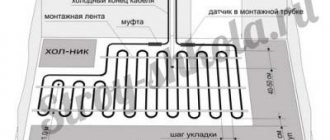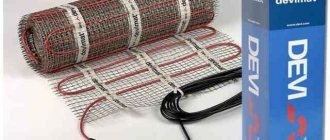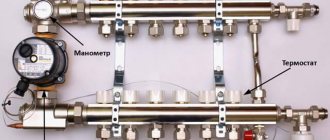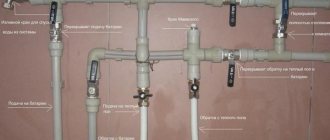Having allocated a considerable amount of funds to create a water heated floor (WF) system, the user sometimes does not receive the expected level of comfort or savings, which supporters of such heating vying with each other about. And if the calculation of communications was carried out correctly, and the installation was carried out without errors, then, most likely, the reason for the ineffectiveness of the thermal installation is in its incorrect functional settings. These primarily include adjusting the temperature of the warm water floor. At the same time, it is based on the concepts of the temperature of the coolant in the system and the surface of the floor covering, as well as the temperature regime in the rooms.
Let's look at how these concepts are linked together in practice, with different methods of TP management.
Optimal temperature parameters
The preferred temperature of the heated floor is selected according to individual needs. After all, some people like invigorating freshness in the house, while others want to bask in the warming energy flows. However, there are generally accepted standards for the preparation of coolant, heating of floor coverings and, accordingly, indoor air. They are determined by sanitary and technological requirements. These standards have already been mentioned here, however, let us briefly recall:
- The optimal floor surface temperature is 280C;
- if the room is designed for a long stay of residents or there are other heating sources, then it is advisable to reduce the temperature to 22-260C - this energy mode is optimal from a medical point of view. In addition, heating of the coatings is unnoticeable upon bodily contact with them, which does not cause tactile discomfort;
- for rooms where the heat supply is the only source of heating, as well as where residents are present only periodically (bathroom, toilet, hallway, loggia, covered veranda), the surface temperature of the floor covering can be raised to 320C.
Ways to control the temperature of a heated floor
To ensure the specified requirements of sanitary and technological standards, user preferences, the heated floor can be adjusted using the following adjustment methods:
- temperature of the coolant entering the TP system. The main control of the heat flow intensity is carried out by changing the settings of the heat generator (boiler). It is suitable only when supplying low-temperature coolant, when a separate boiler operates to compensate for heat loss from underfloor heating. This control method is the simplest, although ineffective, therefore it is rarely used in small private TP systems;
- collectors and mixing units. Such adjustment can be manual or automatic, carried out individually for each circuit or as a whole for the entire heating group - on a common comb through which several TP branches are supplied with coolant.
The starting points for changing system settings can be measurements of the coolant temperature in the supply or return distributors. Indeed, for water heating, unlike electric heating, it is not typical to install thermal sensors in the floor structure - they are mounted directly on the collectors. Most often, such sensors or sensitive elements are parts of thermostatic valves, through which the heated floor is adjusted.
Control signals to automatic devices can also come from air temperature sensors located in heated rooms.
About the role of the sensor
It should be remembered that in setting up a heated floor there is one irreplaceable part - this is the sensor. The control unit adjusts the floor heating and saves electricity. Programmable devices provide the greatest savings, but they are expensive.
The ability to customize the heated floor as needed saves energy and, accordingly, money.
The effect lies in the correspondence between the electrical power of the floor and the meter. Heating the floor to the required temperature is only possible with sufficient power. Therefore, when purchasing, you need to be interested in the characteristics of the product.
In some cases, in large rooms it is necessary to connect more than one regulator.
An important point is the type of setting. You should find a way for yourself not to make holes in the wall, but to limit yourself to a box for a thermostat. Do not deviate from the recommendations in the instructions.
Both functionality and appearance are all significant factors. You can consult with specialists. You need to be especially careful when installing insulated floors in rooms exposed to moisture (bathrooms).
Under no circumstances should the control unit be installed inside; you need to run the cable to the heaters through a hole in the wall and place the sensor in the corridor.
We recommend: How to install Q-Term heated floors?
Electronic tuning equipment is capable of servicing different operating modes of floor heating with a high degree of energy saving. But this is an expensive technique.
- Related Posts
- What is a mobile heated floor?
- How is the mesh for underfloor heating installed?
- How to turn on the heated floor?
- How to connect a heated floor from a stove?
- How to install a film heated floor?
- What kind of liquid should be used for underfloor heating?
Manual adjustment of TP collectors
The simplest, although time-consuming, setting method is to adjust the temperature of the heated floor using manual valves. The task is somewhat simplified by installing flow meters (rotameters) on the comb.
Flow meters simplify the dosage of the amount of circulating coolant (flow) in one separate circuit of the underfloor heating system. In the case of group temperature control throughout the collector, the rotameter can also be used to balance the flow of coolant (smoothing out the difference in hydraulic resistance) along loops of different lengths.
The main elements of a flow meter valve are:
- housing with shut-off and control valve. It is screwed into the corresponding technical hole of the manifold;
- a flask made of transparent plastic or glass with a printed scale;
- float indicator that allows you to visually control the flow of liquid through the rotameter.
Manual adjustment of the underfloor heating manifold is carried out by screwing/unscrewing manual valves or adjusting the throughput of flow meters.
Important! Improvement in the efficiency of the underfloor heating system, as a result of its manual adjustment, will be noticeable only in the case of intensive circulation of the coolant through it. This can only be achieved by using a separate heat pump.
The sequence of manually setting the temperature of a warm water floor
At the beginning of the adjustment operations, it is necessary to make sure that the pipelines of the TP system (secondary circuit) are completely filled with coolant and have no air pockets. They are filled following the main heating system (primary circuit). At this time, all shut-off and control valves on the collectors must be closed.
After opening the main valves for the supply and return of the distributors for heated floors, the shut-off devices on each of the loops are opened sequentially. Air is bled through Mayevsky valves or automatic comb air vents. It is recommended to fill the next branch only after the previous one has been completely filled and its air has been guaranteed.
Having completed filling the first loop, it is necessary to turn on the heat pump of the secondary heating circuit and circulate the coolant through its system. The efficiency of liquid circulation is checked with built-in or overhead thermometers. As a last resort, you can simply put your hands on the supply and return pipes at the same time - they should be warm, but with a slight difference in heating.
The filled first loop should be cut off from the collectors at both ends using local shut-off and control valves. Then, the above actions are carried out with the next loop.
After sequential filling of all heat pump circuits, their shut-off devices are opened and the heat pump is switched on to operating mode. The temperature of the warm water floor is adjusted through the supply of coolant to each of its branches. It is set by changing the liquid flow rate (with a valve or rotameter), and control is carried out by changing the temperature gradient between the supply and return flow. Ultimately, this difference for different circuits should be the same, within 5-150C. The longer the loop, the more intense the coolant will cool and the greater its consumption required.
Important! Heat exchange in underfloor water heating systems occurs with great inertia. The delay in heating the coating surface is especially noticeable if the pipes are laid in too thick a concrete pour (over 60-70 mm). Sometimes the effect of changing the coolant supply intensity becomes noticeable only after a few hours.
To monitor the correct adjustment of a warm water floor, it is rational to use non-contact laser or contact electric thermometers. Their installation to measure the temperature of the supply and return pipes will help reduce the time to obtain the result of changing settings from several hours to 10-15 minutes.
Automatic temperature control of TP
Automatic adjustment of a heated floor can be carried out thermomechanically or electronically using electromechanical actuators that control the operation of shut-off valves.
Thermomechanical control system
It is based on the operation of thermostatic valves or taps with thermal heads that respond to changes in coolant temperature. Various models of such shut-off and control valves are offered today by many manufacturers, for example, Oventrop. However, regardless of the name and type of thermosetting substance used in them (liquid or gas), these are thermomechanical self-regulating mechanisms that are most appropriately installed to control the temperature of one, individual circuit.
The operating principle of thermal valves is simple, which makes them very reliable and fault-tolerant. A copper, brass or bronze core installed in the device body, heated by the passing coolant flow, transfers the temperature to the thermosetting filler. In turn, the thermosetting element, which increases in volume, pushes the core, which, by moving the valve, gradually blocks the circulation of the heated liquid.
The thermostatic valve for heated floors, in addition to being installed on the distribution comb, can be mounted in a separate “unibox” type assembly. Such assemblies also include automatic air vents, which, together with thermostats, are placed in compact boxes (boxes). The use of a “unibox” allows you to adjust the temperature in a separate branch of the TP without being tied to bulky manifold cabinets, which is especially convenient with a small number of circuits.
In addition, thermomechanical floor heating controllers can have remote air sensitive elements. They allow you to configure them to control the flow of coolant not according to its temperature, but according to the air temperature in the rooms. The principle of their operation is the same, only the thermosetting substance is much more sensitive. It is advisable to install an air thermal head for simultaneous control of several circuits in one room, where water underfloor heating is the only source of heating.
Electronic control system
It consists of electronic thermometers, a controller and electric drives (actuators, servos). Electric drive mechanisms can be attached to the mixing heads of conventional control valves (valves) or be part of their design. The change in coolant supply intensity is carried out in accordance with specified threshold values. The measuring medium for the temperature sensors of the automatic floor heating temperature controller can be both the coolant and the air in the premises.
Important! Such control equipment is quite expensive, but at the same time it is capable of providing optimal operating conditions for underfloor heating and maximum energy savings. In addition, electronic regulators allow programming of the TP with binding of its operating modes to different time periods, which guarantees the user maximum thermal comfort.
Thermal regulation of electric floors
The electric unit that warms the floor can be configured, and the operation of the heating device can be adjusted. This is done by turning the heating on and off, adjusting the temperature, and adjusting the repeatability of the process of turning the thermal elements on and off.
Thermostats for electric heated floors
Special panels allow you to control the electric adjustable floor. They differ in appearance, in the installation destination, in the means of fastening and in the number of connected sensors.
Thanks to the control panel, energy is saved and the temperature can be adjusted without overheating.
The operating principle of the panels is special:
- An electric heated floor is set up quite simply using an electronic-mechanical regulator with a meager set of functions. Manual control of a wheel like an iron. The wheel is connected to a regulator that maintains a constant temperature. In this case, simplicity is the best solution both in terms of price and strength (rarely breaks, easy to repair);
- The digital control panel functions as an electronic mechanical regulator. The difference is that instead of a wheel there are buttons or a sensor. The control unit is equipped with electric sensors that measure the overall temperature in the apartment and transmit this data to thermostats;
- A modern detail is a thermostat that can be programmed. It has several sensors built into it to measure temperature indicators. These sensors send information to the control device (controller). It is capable of simultaneously maintaining different temperatures in individual rooms;
- and the most modern regulators are controlled from the Internet. For example, when leaving home, you can turn off the heating, and when returning home, turn on the system from your phone. The floor will be warm when you arrive.
We recommend: How to install an electric heated floor?
When choosing your underfloor heating option, it is recommended to take a closer look at the digital project. The advantages consist of ease of use and affordable price.
In addition, the variety of design solutions helps to integrate into the overall flavor of the apartment’s design. It is also important that the dimensions of the sensors and heating objects match.











